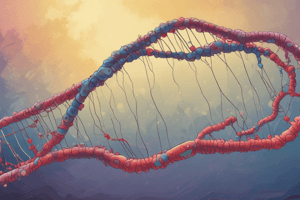Podcast
Questions and Answers
What type of elements can act on any different splice site on the genome?
What type of elements can act on any different splice site on the genome?
- Trans acting elements (correct)
- Spliceosome proteins
- Cis elements
- snRNPs
Which type of proteins bind to sequences in exons and recruit components of the core splicing machinery?
Which type of proteins bind to sequences in exons and recruit components of the core splicing machinery?
- heterogeneous nuclear ribonucleoproteins (hnRNPs)
- SR Proteins (correct)
- Splicing repressors
- Splicing activators
What is the function of the exon junction complex (EJC)?
What is the function of the exon junction complex (EJC)?
- To remove the first round of translation
- To recycle back into the nucleus
- To deposit 24 nucleotides upstream of spliced junctions during splicing (correct)
- To stabilize the complex
What is the outcome of Alternative splicing?
What is the outcome of Alternative splicing?
What is the function of nonsense-mediated mRNA decay (NMD)?
What is the function of nonsense-mediated mRNA decay (NMD)?
Which type of RNAs are involved in post-transcriptional control?
Which type of RNAs are involved in post-transcriptional control?
What type of splicing involves splicing between two pre-mRNA molecules?
What type of splicing involves splicing between two pre-mRNA molecules?
What is the function of heterogeneous nuclear ribonucleoproteins (hnRNPs)?
What is the function of heterogeneous nuclear ribonucleoproteins (hnRNPs)?
What is the primary mode of action of regulatory RNAs?
What is the primary mode of action of regulatory RNAs?
What is the main function of molecular chaperones?
What is the main function of molecular chaperones?
What is the primary function of heat shock proteins HSP60 and HSP70?
What is the primary function of heat shock proteins HSP60 and HSP70?
What is the purpose of ubiquitination?
What is the purpose of ubiquitination?
During co-translational folding, where does protein compaction occur?
During co-translational folding, where does protein compaction occur?
What is the function of the chaperonin HSP60?
What is the function of the chaperonin HSP60?
What is the characteristic of regulatory RNAs that reflects their function?
What is the characteristic of regulatory RNAs that reflects their function?
What is the purpose of ATP hydrolysis in the HSP70 chaperone cycle?
What is the purpose of ATP hydrolysis in the HSP70 chaperone cycle?
Flashcards are hidden until you start studying
Study Notes
Splicing
- RNA molecules, in complex with proteins, perform key steps in splicing, rather than proteins alone.
- Cis elements involved in splicing include:
- 5' splice site (donor site)
- 3' splice site (acceptor site)
- Branch point
- Polypyrimidine tract
- Trans-acting elements can act on any different splice site in the genome.
Alternative Splicing
- Increases the complexity of the protein that can be generated from available genomic coding sequences.
- Regulated by cis-acting elements, trans-acting factors, transcription, and chromatin structure.
- Alternative splicing is a key regulatory mechanism.
Splicing Activators and Repressors
- SR Proteins:
- Have extensive repeats of serine and arginine.
- Are RNA binding proteins.
- Bind to sequences in exons, recruiting components of the core splicing machinery and activating splicing.
- hnRNPs (heterogeneous nuclear ribonucleoproteins):
- Are RNA binding proteins.
- Bind to sequences in exons or introns.
- Interfere with the binding of core splicing machinery, repressing splicing.
Trans Splicing
- Involves splicing between two pre-mRNA molecules.
- Involves the same signals and components as cis splicing.
- Occurs in a variety of organisms, including Drosophila and C. elegans.
- In mammalian cells, can be associated with cancer.
Nonsense-Mediated mRNA Decay (NMD)
- Is a RNA quality control mechanism.
- Eliminates transcripts with premature termination codons (PTCs).
- Premature stop codons can arise from mutations, defects in splicing or transcription.
- Is a gene regulatory mechanism that also targets non-mutant transcripts.
Exon Junction Complex (EJC)
- Is deposited 24 nucleotides upstream of spliced junctions during splicing.
- Is removed by the first round of translation and recycled back into the nucleus.
- The core consists of 4 proteins: eIF4A3, MAGOH, RBM8A, and BTZ.
Post-transcriptional Control by Non-coding RNAs
- Non-coding RNAs include:
- "House-keeping" RNAs (e.g., rRNAs and tRNAs)
- Regulatory RNAs, including small ncRNAs (200 nucleotides)
- Main mode of action: scaffold to recruit proteins, DNA, and/or RNA.
Post-translational Control
- Protein folding involves:
- Polypeptide chain folding into a unique 3D conformation.
- Final secondary structures, including α-helices and β-sheets.
- Most hydrophobic residues are hidden in the interior core.
- Co-translational folding occurs within the polypeptide exit tunnel and at the surface of the ribosome.
Molecular Chaperones
- Molecular chaperones recognize incorrect configurations due to the exposure of hydrophobic surfaces.
- Heat shock proteins (HSP60 and HSP70) are molecular chaperones.
- HSP70:
- Functions early, sufficient for many proteins.
- ATP-bound HSP70 binds to exposed, short stretches of hydrophobic amino acids and hydrolyses ATP to ADP.
- Provides opportunity to fold correctly, prevents mis-folding, and formation of aggregates.
- Releases the protein when ATP has been exchanged for ADP.
- HSP60 (chaperonin):
- Acts later, provides a barrel-shaped isolation chamber.
- Substrate captured via hydrophobic entrance (helps with unfolding).
- Binding of ATP and sealing with cap releases protein into chamber.
- Protein re-folding in isolation.
- ATP hydrolysis weakens binding of cap.
- Binding of new ATP ejects cap and releases protein.
Marking Proteins for Degradation - Ubiquitination
- Ubiquitin is a small, 76 amino acid protein.
- Ubiquitin is heat-stable and highly evolutionarily conserved.
- Ubiquitin is expressed in all eukaryotic cells.
- Glycine 76 binds to a lysine residue on the substrate.
Studying That Suits You
Use AI to generate personalized quizzes and flashcards to suit your learning preferences.




